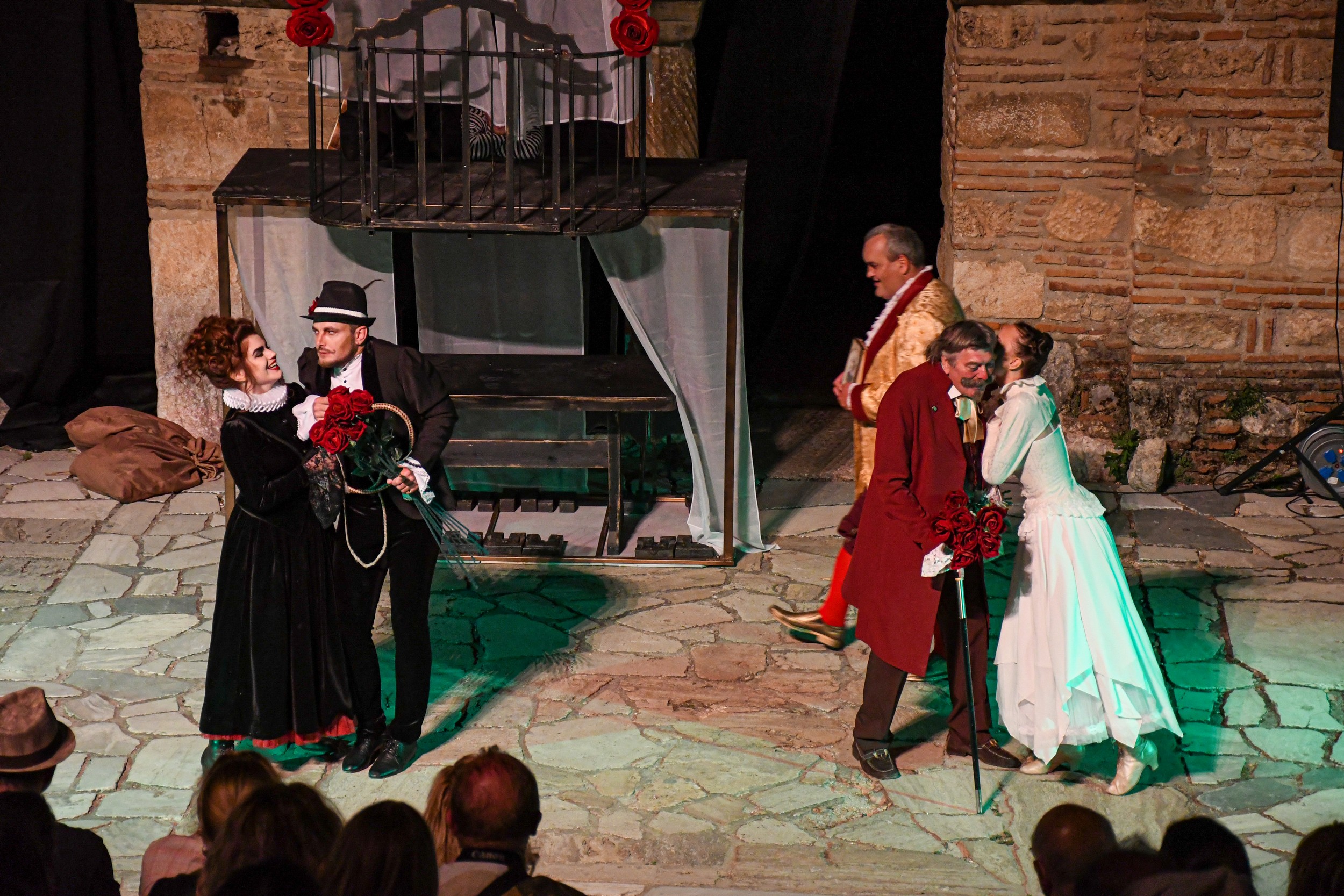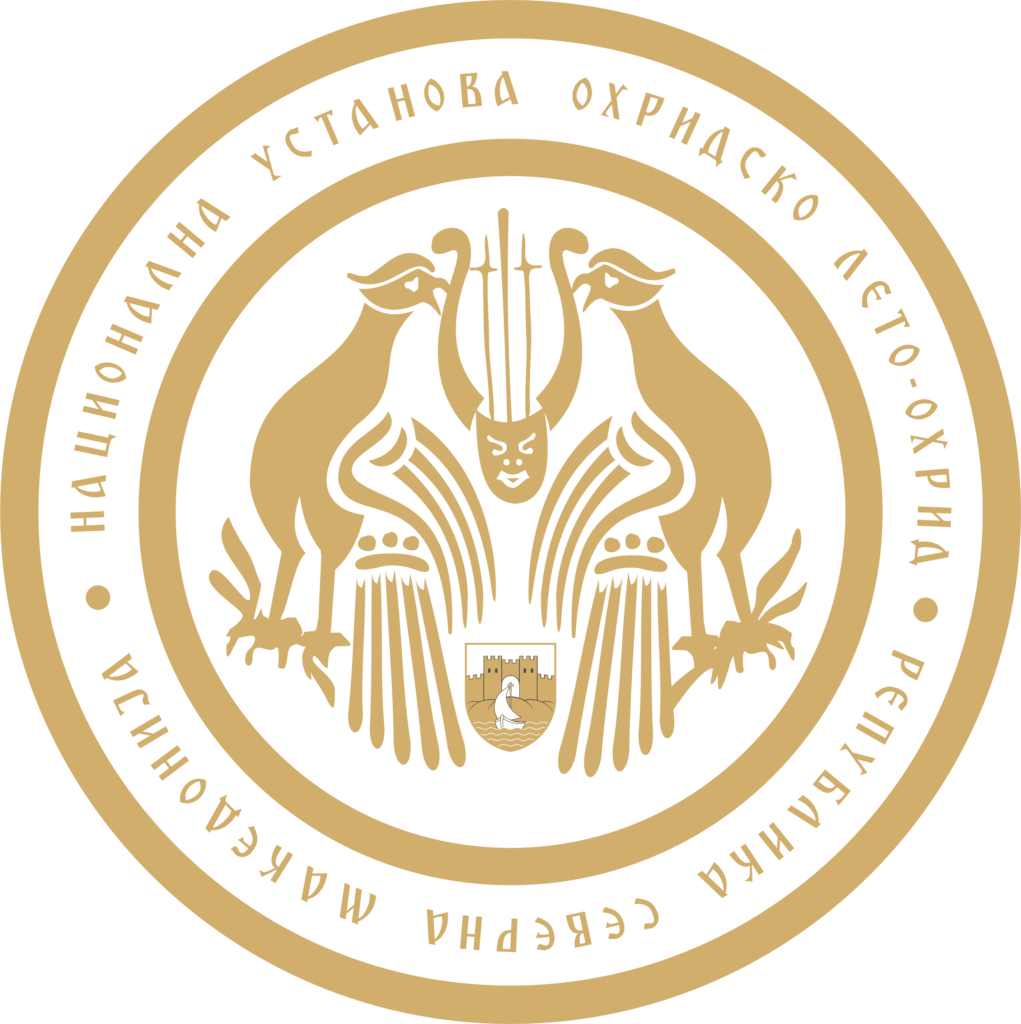
The war is over, at least on stage. Theatre is life, life is treatre!”. This is the last line of the play “Taming of the shrew” by William Shakespeare, directed by Viktorija Shevchenko, performed by the Kyiv Academic regional music and drama theatre “P.K. Saksaganski”
Kyiv Academic regional music and drama theatre “P.K. Saksaganski” from Ukraine, which opened the international theatre programme of the Ohrid Summer Festival.
The director, actors and crew of the play produced by Kyiv Academic regional music and drama theatre “P.K. Saksaganski” – entitled by the actor, director and playwright Panas Karpovic Tobilevic, with artistic name Saksaganski (1859-1940), a leading person in the Ikrainian theatre in the firs part of the 20th century – will give anything to make their “love war” end up the real war going on in Ukraine on that evening on 1st August at the Vestibule of the St Sophia church, where they played. However, the mere act of play performance of a Ukrainian theatre in the country, and, as is the case with the theatre “P.K. Saksaganski”, for the first time at Ohrid Summer Festival, gives another dimension to the well-known saying about the theatre stage: as the final line from the end of the play, theatre is life, life is theatre, no matter how cruel and tough.
It is unusual to compare various theatre settings with filmed versions of such classic pieces, but “Taming of the Shrew” is quite a popular title as a clause outside the theatre world, in the popular culture. Famous for the ten-some filmed versions – among which the most important is the one from 1967 directed by Franco Zeffirelli, with Elisabeth Taylor and Richard Barthon in the leading roles, “Taming of the Shrew” is often used as a synonym for many female individuals throughout the history.
Written towards the end of the 16th century, “Taming of the Shrew” in considered the first in the three-pack comedy set written by Shakespeare (1564-1616), which includes “Comedy of Errors”, which later becomes a term for a specific sub-genre throughouth the centuries. As an illustration, in that sub-genre belong “Solunski Patrdii” and “Weekend of Deceased Persons” by the Macedonian playwright Mile Poposki (1922-2009).
The action in “Taming of the Shrew” happens in Padua, reveling around the two daughters of Batista Minolla, the older Katherine (or Kate) and the younger Bianca, Batista (played by Roman Vdovika) holds the conservative order and wants to marry the older, Katherine (Marharita Ovcharova), first, and later Bianca (Anastasija Karabuha). Katherine has no courters because she isn’t as gentle and beautiful as Bianca, but she is known to be very cunning, a bit neurotic, so hardy any man would take the risk to try handling her.
The plot begins when in Padua arrives the aristocrat Petruchio (Vladislav Krasikov) from Verona, a temperamental bohemian, ready to marry Katherine for her dowry, but that is a kind of a challenge for him, because apart from the turbulences she is prone to cause, he is also of a moody personality. From the other side, for Bianca’s hand there are three suiters: Hortenzio (Boris Ponomarenko), aristocrat from Padua, friend of Petruchio and his “matchmaker” for Katherine; Hremio (Yevhen Todorakin), older rich man; and Luccenzio (Ruslan Taran), young and handsome student from Pisa, descendant of a rich Firenze family, with a resourceful servant Tranio (Vladislav Dubinin). The latter two exchange their identities in order to expel al the other candidate grooms for Bianca. But will Katherine be tamed at the end? The cunning Tranio even organizes a kind of a bet between the characters for that question, with an interesting ending…
The director Viktorija Shevchenko (1992), who set “Taming of the Shrew” in the Kyiv theatre in 2019, creates a new creative reading of the Shakespeare’s comedy, with notable costume design and make up. Shevchenko, who has set “Romeo and Julia”, Alice in Wonderland”, “They” according to the play by M. Stefanik, “Natalka Poltavka” by Ivan Kotliarevski, “Uncle Vanya” by Anton P. Chehov in the past few years, in this occasion uses comic-like sceves, where the plastic play of the actors is exposed, among which Svitlana Lanovenko (the widow) and Oleksay Almaz, Mikola Holovchak, Valeriy VOitov, Oleksandr Samojlenko and Dmitro Kupreichuk as servants.
From another side, “Taming of the Shrew” on the stage at the vestibule of the St Sophia church way look “naked and bare” at the stripped stage from stone plates, with minimum scenography which the theatre “P.K. Saksaganski” brought this time, and only with basic light setting. But, those very conditions gave another dimension to “Taming of the Shrew”. In the first part of the play we witnessed a “condensed” Shakespearian dialogue, but in the second part the actors raised the setting to a level of a playful “rush” on stage, suitable for a typical Mediterranean comedy of errors under open skies, with the necessary improvisations.
“The war destroyed the magic of theatre”, said the Ukrainian artists at the press conference before the performance. But, recalling the UK statesman Winston Churchill, the actor Krasikov thinks that each war is aimless inless it raises culture on a higher level through those war circumstances.
After the WWII, the German philosopher Theodor Adorno (1903 – 1969) set the famous ethical dilemma whether writing poetry after Auschwitz is barbarism. That Weltschmerz (in German: world pain), a term used by Romantics two centuries ago to describe the collective feeling of sorrow and helplessness, over and over again puts the artists in a situation to explain the humanity why they make plays, act, direct, write poetry, prose and novels, make films, paint canvases and walls…
The performance of the Kyiv theatre at Ohrid Summer Festival with the play “Taming of the Shrew” in such conditions is one more pieca in the mosaic of “brilliant and awful” challenges the artists are faced with.
Stojan Sinadonov.

